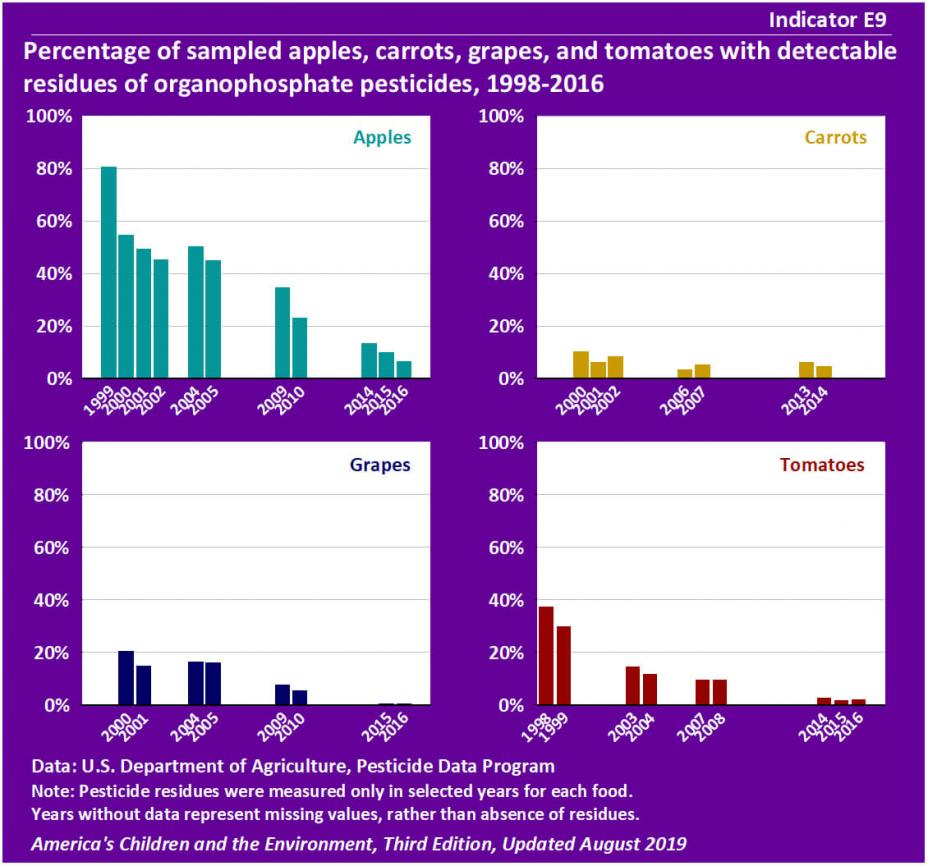ACE: Environments and Contaminants - Chemicals in Food
- Indicator E9 – Percentage of sampled apples, carrots, grapes, and tomatoes with detectable residues of organophosphate pesticides, 1998-2016
- Background Text
- Methods
Indicator E9
![]()

Data characterization
- Data for this indicator are obtained from a U.S. Department of Agriculture program that measures pesticide residues in food samples collected from 10 states.
- Food samples are randomly selected from the national food distribution system and reflect what is typically available to the consumer.
- The types of foods sampled change over time; so, for example, data for pesticide residues on apples are not available every year.
- The indicator is calculated using the measurement sensitivity as of 1998 for each year shown; more sensitive measurement techniques have been incorporated over time.
- In 1999, 81% of sampled apples had detectable organophosphate pesticide residues. In 2016, 6% had detectable residues.
- In 2000, 10% of sampled carrots had detectable organophosphate pesticide residues. In 2014, 5% had detectable residues.
- In 2000, 21% of sampled grapes had detectable organophosphate pesticide residues. In 2016, less than 1% had detectable residues.
- In 1998, 37% of sampled tomatoes had detectable organophosphate pesticide residues. In 2016, 2% had detectable residues.
Background Text
About the Chemicals in Food Indicator
Indicator E9 presents information on detectable pesticide residues in sampled apples, carrots, grapes, and tomatoes. The data are from an analysis of pesticide residues in foods conducted each year.
Food contamination can come from multiple sources, including antibiotics and hormones in meat and dairy products, as well as microbial contamination that can lead to illness. In addition, a wide variety of chemicals from man-made sources may be found in or on foods, typically at low levels. Chemicals in foods may come from application of pesticides to crops, from transport of industrial chemicals in the environment, or from chemicals used in food packaging products. Some chemicals in food are naturally occurring and some are from man-made sources, such as application of pesticides to crops. Chemicals of concern for children's health that are frequently found in foods include methylmercury, polychlorinated biphenyls (PCBs), polybrominated diphenyl ethers (PBDEs), bisphenol A (BPA), phthalates, perfluorochemicals (PFCs), perchlorate, and organophosphate pesticides.
The health risks from chemicals in food are dependent on both the actual level of a chemical in the food as well as the amount of the food consumed by individuals. Several chemicals that can be found in foods have been associated with adverse health outcomes including developmental, reproductive, and neurological outcomes. In particular, organophosphate pesticides can interfere with the proper function of the nervous system when exposure is sufficiently high. Since 1999, EPA has imposed restrictions on the use of some organophosphate pesticides on certain food crops and around the home largely due to concerns about potential exposures of children and possible health effects.
Indicator E9 presents data on pesticide residues in food from the U.S. Department of Agriculture (USDA) Pesticide Data Program (PDP).
More information about chemicals in food and Indicator E9 is provided in the Chemicals in Food section of America's Children and the Environment, Third Edition.
Related Links
Centers for Disease Control and Prevention (CDC): Food Safety
U.S. Department of Agriculture (USDA): Food Safety
U.S. Department of Agriculture (USDA): Food Safety and Inspection Service (FSIS)
U.S. Department of Agriculture (USDA): Pesticide Data Program
U.S. EPA: Protecting Children from Pesticide Exposure
Methods
Summary of Methods - Chemicals in Food
The U.S. Department of Agriculture (USDA) collects data on pesticide residues in food annually. USDA's Pesticide Data Program (PDP), initiated in 1991, focuses on measuring pesticide residues in foods that are important parts of children's diets, including apples, apple juice, bananas, carrots, grapes, green beans, orange juice, peaches, pears, potatoes, and tomatoes.
Samples are collected from food distribution centers in 10 states across the country. The PDP has a statistical design in which food samples are randomly selected from the national food distribution system and reflect what is typically available to the consumer, including both domestic and imported foods.
Indicator E9 uses the PDP data to present the percentage of sampled apples, carrots, grapes, and tomatoes* with detectable residues of organophosphate pesticides. These four foods were selected from those sampled because they were among the 20 most-consumed foods identified in an analysis by EPA and because data for these foods were available for multiple years.
* Each sample tested is a composite of multiple apples, carrots, grapes, or tomatoes. Thus, the percentages reported correspond to the number of composite samples of apples, carrots, grapes, or tomatoes with detectable organophosphate pesticide residues, and do not necessarily correspond to the number of individual apples, carrots, grapes or tomatoes with detectable organophosphate pesticide residues.
Detailed Methods for Indicator E9
Metadata for Pesticide Data Program
